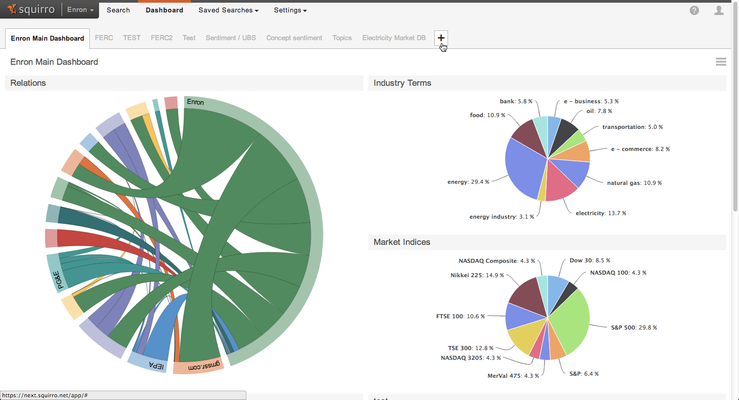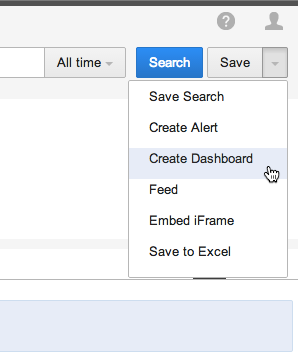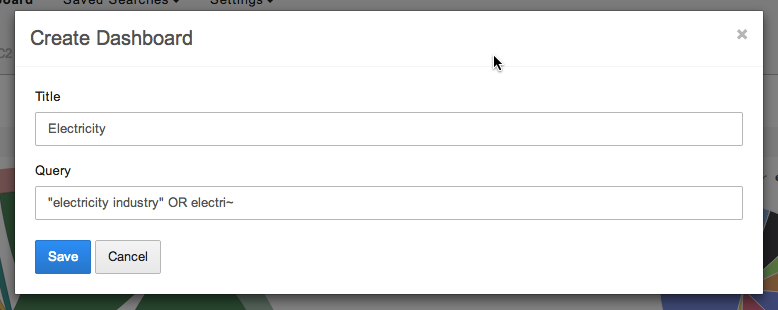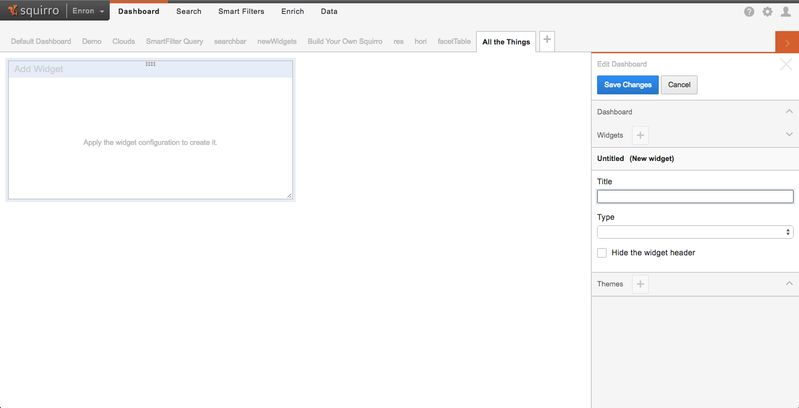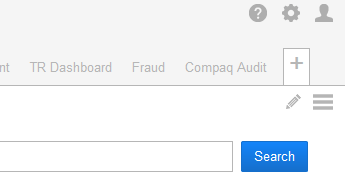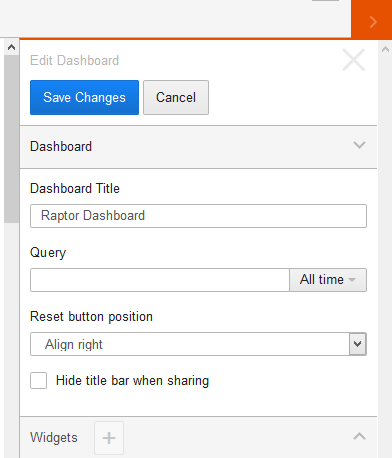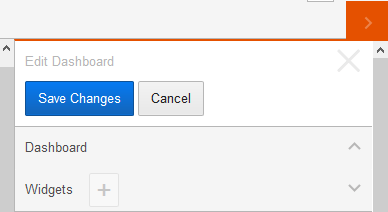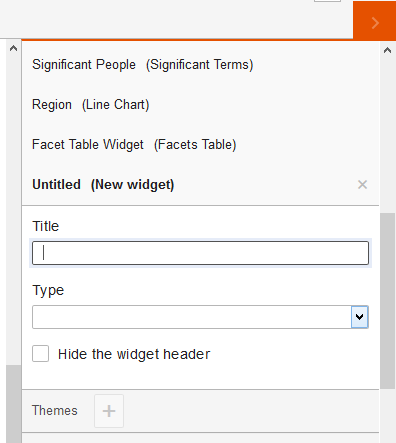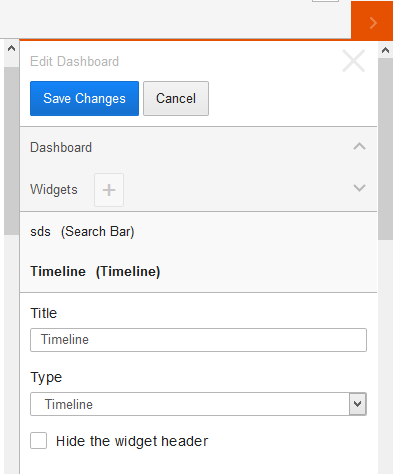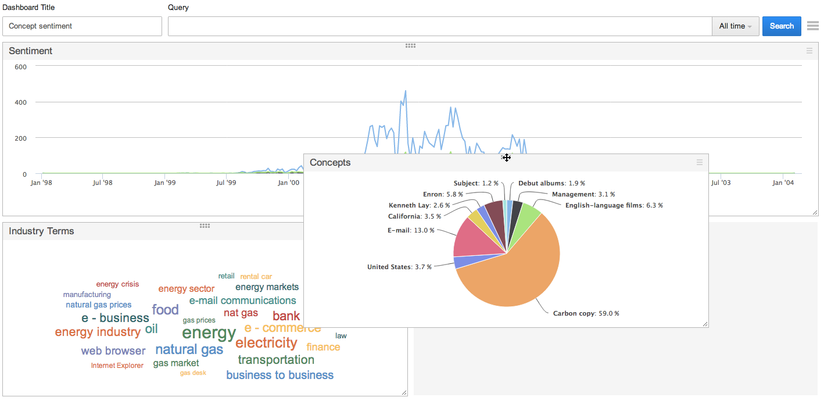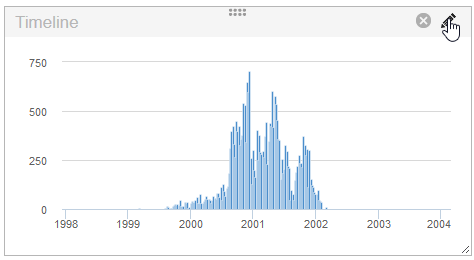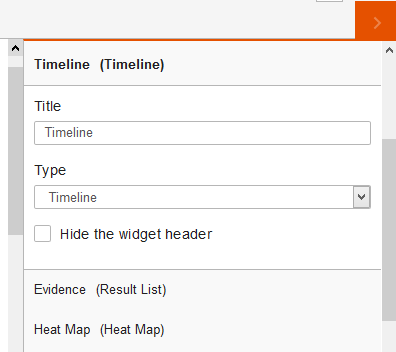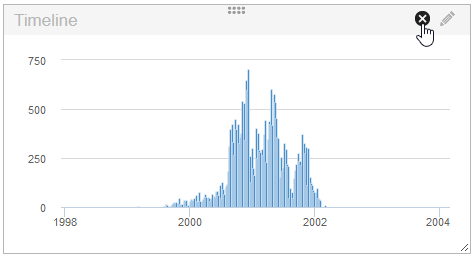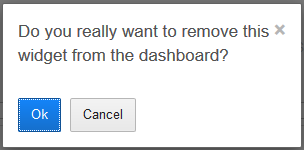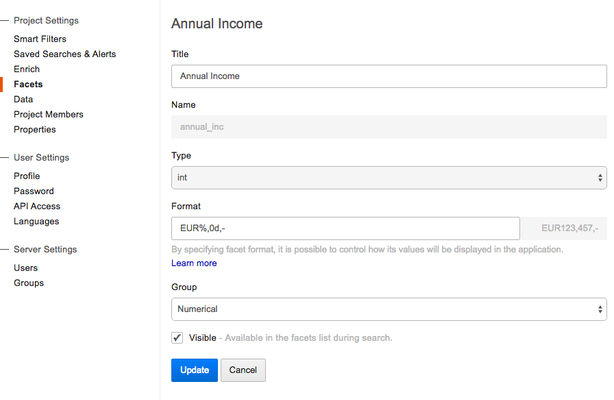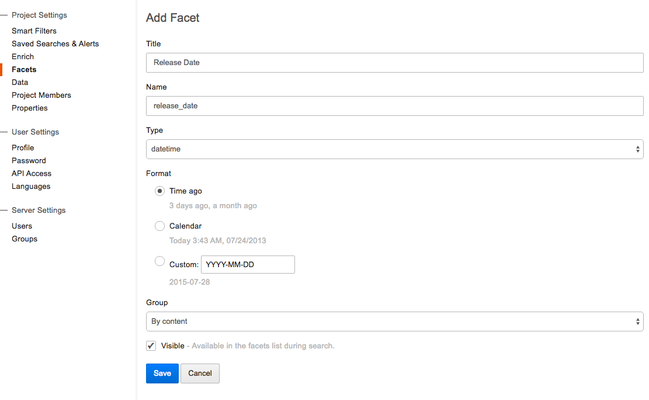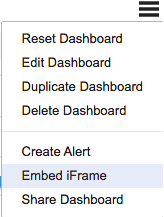Dashboards are visual representations of data. Squirro supports extensive dashboarding functions, allowing you to have real-time visual representations of data as you search.
Table of Contents
Creating dashboards
To create a dashboard,
- Open the Dashboard page by clicking on
Dashboardin the top menu. - Click on the + sign at the end of the list of existing dashboards.
- Alternatively, you can use the save button's dropdown to create a dashboard from the current search query.
- Name your dashboard and provide an initial query (you can change both the name and the query later on). To include all documents, leave the query empty.
- Press SAVE.
Directly after creation, you are presented with a fresh dashboard, an empty widget and a configuration panel for it.
- Continue with the next sections to learn how to configure the newly created dashboard.
Editing dashboards
To enter editing mode,
- Click on the pencil icon in the top right corner of the dashboard:
You are now in editing mode.
Change title and query of dashboard
To change your dashboard's main query or title,
- Enter editing mode using the steps described above,
- In the edit sidebar to the right, open the Dashboard section
Enter the title and query as desired.
Once done, press the
Save Changesbutton at the top to save your changes or press Cancel to abandon them.
Widgets
Widgets are the building blocks of a dashboard. Each widget represents data in a particular form. Currently, Squirro offers a number of built-in widgets, such as pie charts, time frequency graphs (line charts) and word clouds.
Widget types
The available widget types are listed on the page Widgets.
Add widget
To add a widget,
- Enter edit mode on the dashboard,
- In the edit pane on the right, press the plus button next to the "Widgets" header.
- Set a title and the widget type to use in this form.
See the Widgets documentation for information about the various widget types. - Depending on the widget type, additional configuration options may be displayed and required.
- Changes made in this form are applied immediately to the dashboard, but not yet saved.
- To save the changes, use the
Save Dashboardbutton at the top of the edit sidebar.
Moving widgets
To move a widget,
- Enter editing mode as described above,
- Click on the handle in the middle of the top frame of the widget,
- Drag widget using the handle.
Editing widgets
To edit a widget,
- Enter editing mode as described above,
- Click on the pencil icon in the right upper corner of the widget's frame,
- The widget is activated in the edit panel on the right side of the screen.
- Changes made in this form are applied immediately to the dashboard, but not yet saved.
- To save the changes, use the
Save Dashboardbutton at the top of the edit sidebar.
Deleting widgets
To delete a widget,
- Enter editing mode as described above,
- Click on the delete icon in the right upper corner of the widget's frame,
- Confirm the deletion in the resulting dialog.
Facet Value Formatting
It is possible to format the values of numerical and date facets to be displayed in the dashboard widgets.
To do so, one can define the facet formatting screen in the Facets management section of Squirro.
Formatting of numerical facets (of type int or float)
The string defined in 'Format' section will be used to display the facet values in Dashboarding. Any string can be used to that purpose, and a preview of the formatting is visible to the right of the format input field.
To inject the actual facet value into the resulting string, %d placeholder is used.
| Formatting String | Result for a facet value of 123456.789 |
|---|---|
| %dEUR | 123456.789EUR |
| $%d | $123456.789 |
Additional formatting options are available for the %d placeholder, allowing to define the separator between each magnitude of 1000, as well as the symbol used to the floating point, in the case of values of float datatype.
| Formatting String | Result for a facet value of 123456.789 |
|---|---|
| %'dEUR | 123'456.789EUR |
| %.,dEUR | 123.456,789EUR |
| %',dEUR | 123'456,789EUR |
It is also possible to specify the rounding precision of floating point values, after the floating point.
| Formatting String | Result for a facet value of 123456.789 |
|---|---|
| %2dEUR | 123456.79EUR |
| %,1dEUR | 123456,8EUR |
| %',0dEUR | 123'457EUR |
Formatting of facets of type Date
To format facet values containing dates (and times), Squirro offers three formatting options, defined in the Facets configuration screen.
Each option is accompanied with a preview of the resulting formatted value.
Embedding and Sharing Dashboards
To share or embed the current dashboard,
- Click the Dashboard Setting Button and select "Share Dashboard" or "Embed iFrame"
The Embed iFrame offers an iframe HTML tag, which can be used for embedding the dashboard in a 3rd-party web site or application. The Share Dashboard option offers a URL, which can be easily shared via email or other means.
Dashboard URL API Reference
The URL which is generated by the Embed and Share options in the dashboard can be extended with additional options. The following URL parameters can be used to change the behavior of the dashboard.
| Parameter | Description | Example Value |
|---|---|---|
| query | Override the Dashboards search query | &query=(blue OR green OR red) |
| selection | Set the Foreground query for all Significant Terms widgets | &selection=blue |
| created_before | Only display results with a created_at value lower than this | &created_after=2012-12-31 |
| created_after | Only display results with a created_at value higher than this | &created_before=2014-12-31 &created_before=2014-12-31T18:30:00 |
| relative_start | Only display results with a created_at value higher than this, in relative terms to today | &relative_start=2y |
| relative_end | Only display results with a created_at value lower than this, in relative terms to today | &relative_end=1y &relative_end=4w |
